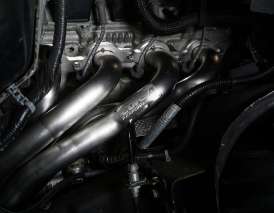Along with a better-flowing intake and exhaust, performance headers are among the first aftermarket modifications any car enthusiast should consider. But what are headers and how do they improve performance? Your engine is most efficient in terms of power and economy when it can easily get air in and out of its cylinders. That's why most performance-boosting modifications boil down to "more fuel and air."
Aftermarket upgrades like cold air intake systems, high-performance headers and aftermarket exhaust systems all aim to make your intake and exhaust system less restrictive. They increase the flow of air into your engine and ease the flow of exhaust gas out to achieve performance benefits. In this article, we'll focus solely on aftermarket headers, including how they work and how they can help improve your ride's performance.
Table of Contents
|
> Performance Headers vs. Stock Exhaust Manifolds: What's the Difference? |

Performance Headers vs. Stock Exhaust Manifolds: What's the Difference?
As you know, your car's exhaust system isn't just one continuous pipe – it's comprised of multiple subsections. Your stock exhaust manifold is in the front and is the piece that attaches directly to your engine.
Exhaust manifolds are constructed as a single pipe connected to each engine cylinder. Exhaust gases flow out from each cylinder and into the manifold pipe, then proceed down the exhaust system into the catalytic converter and muffler before exiting the exhaust pipe.
In contrast, a performance header is a set of exhaust pipes that individually connect to each engine cylinder. Exhaust gases come together into a larger pipe called a collector before flowing to the catalytic converter and beyond. An aftermarket header's pipes are shaped so that they are the same length once attached to the collector, guaranteeing that each cylinder's exhaust gases arrive equally spaced.
It may seem like a slight difference, but changing how your cylinders connect to your piping with performance headers makes a massive difference in flow dynamics and back pressure.

How Do Headers Improve Performance?
The purpose of headers, like all exhaust systems modifications, is to improve engine performance. But how do they do this? Well-designed exhaust headers produce what is called the "scavenging" effect. When your exhaust headers scavenge, the exhaust gas pulse flows out of the header tube and into the collector, creating a negative pressure wave that will travel back up the header tube during valve overlap. As a result, any remaining exhaust gasses in your engine cylinders are removed, and the incoming intake charge is drawn in.
This is highly beneficial to your engine's performance, as it can help reduce tons of back pressure commonly associated with exhaust manifolds. Back pressure in manifolds is a bottleneck of exhaust gases which prevents the combustion chamber from getting fresh air, decreasing power output and performance.
Installing aftermarket headers, along with other exhaust system components, can help with performance benefits across the board. Larger-diameter, mandrel-bent exhaust pipes and a free-flowing performance muffler can ensure your exhaust gases aren't restricted further down the line.
Shop Performance Exhaust Headers & Other Exhaust Accessories at CORSA
Experience improved performance for yourself with CORSA. What's the point of settling for your stock parts if you're disappointed in your performance? At CORSA PERFORMANCE, we never settle for anything less than the best. Take your exhaust system into your own hands with aftermarket exhaust headers, finely-tuned mufflers, resonator tips and more from CORSA today.
Browse Our Full Line of Exhaust Accessories
Do Headers Add Horsepower?
While it may not make as much of a drastic difference as installing a turbocharger or supercharger, investing in performance headers will increase your engine's torque, subsequently improving your horsepower.
Depending on your vehicle type and how much you've upgraded your exhaust system, installing aftermarket headers can result in a five percent increase in horsepower. It might seem like a small amount, but a five percent increase can mean a world of difference in how your vehicle drives, especially in cars and trucks that have extremely powerful engines already.

What Do Headers Do For a Car's Sound?
While improving your vehicle's power performance is one purpose of headers, they can also help improve your sound performance. Most manufacturers design their exhaust systems to be as quiet as possible, but you don't have to keep it that way. While a stock cast iron exhaust manifold will keep your sound contained, upgrading to 304 stainless steel high-performance headers shows what your ride can do.
While aftermarket headers won't make your car louder, they will improve your overall sound quality. If you were to compare the sound of a revving engine with an exhaust manifold versus a high-performance header, you'd be able to notice the tonal difference immediately. With exhaust headers, your exhaust notes will be smoother, more defined and far more aggressive.
The Two Common Types of Exhaust Headers
While there are actually four main types of exhaust headers you'll come across, shorty headers and long tubes are the two most common you'll find on the market today.
Shorties are generally around the same size as most stock exhaust manifolds. They work in tandem with stock and standard aftermarket mid-pipes. These aftermarket headers act as a direct replacement for your stock exhaust manifold and will not require a tune or extra parts to work with total efficiency. Shorty headers are a common choice for the average daily driver and give good boosts in horsepower and torque in the mid-RPM range.
Long tube performance headers are too long to bolt directly to a stock mid-pipe, so they require the addition of an aftermarket mid-pipe to maintain a consistent exhaust length. You can use these exhaust headers on the race track or the streets, as they generally provide more significant boosts in horsepower and torque than shorties. Long tube performance headers see the most performance gains in the mid-low to mid-high RPM range. However, long tube headers cannot be used with a turbocharged motor and will require a tune.
Choose CORSA for Top-Rated Aftermarket Headers Made for Performance
Don't settle for your stock exhaust manifold – make the switch to high-performance headers today. CORSA PERFORMANCE Corvette C8 aftermarket headers bolt directly to the front of your catalytic converter, are 100% dyno tuned (no tune required upon installation) and are emissions legal in all 50 states. Maximize your flow, accentuate your sound and increase your performance with CORSA headers today. If you have any questions about our products, don't hesitate to reach out. A CORSA expert is always just a call or click away.



![[CLOSE OUT] Black / CORSA Men's T-Shirt | Exhaust Tips](http://www.corsaperformance.com/cdn/shop/products/IMG_0485_edit_square.jpg?v=1709830722&width=104)

![[OPEN BOX ITEM] 3.0 in Downpipe | 2015-23 Ford Mustang EcoBoost 2.3T (14344)](http://www.corsaperformance.com/cdn/shop/files/14344-2015-2019-ford-mustang-ecoboost-downpipe-3-0-sport-to-xtreme-14344-downpipe-745179021328_63440e1a-d143-4f51-9a01-bbec5072ab45.jpg?v=1688997809&width=104)



